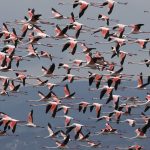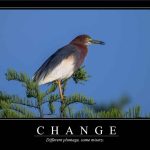…in a pretty poor attempt to make planes safer from bird strikes. The plan is to cull about 2,000 geese from parks and city-owned properties within five miles of Queens’ two airports, at the cost of a cool $100,000. Of course, the Canada Goose population in the region is estimated to be at least 20-25,000, so the city will be removing less than ten percent of the area’s resident geese and another 25,000 or so migrate in or through every fall (to say nothing of Snow Geese and Brant). It seems like a waste of cash and time (and many people will, I am sure, be upset to see geese being captured to be gassed).
Recent Posts
- Urban Birding in Colombo – Diyasaru Wetland ParkBy Luca
 Why Birders Dig DarwinBy Mike
Why Birders Dig DarwinBy Mike 2025: Hitting the TargetsBy David T
2025: Hitting the TargetsBy David T Species Spotlight: Lady Amherst’s PheasantBy Kai Pflug
Species Spotlight: Lady Amherst’s PheasantBy Kai Pflug Interviews with 10,000 Birds Writers: Faraaz Abdool, Trinidad&TobagoBy Editor
Interviews with 10,000 Birds Writers: Faraaz Abdool, Trinidad&TobagoBy Editor Demotivational Posters for Birds (XI)By Kai Pflug
Demotivational Posters for Birds (XI)By Kai Pflug 5 Reasons To Love Cats And BirdsBy Kai Pflug
5 Reasons To Love Cats And BirdsBy Kai Pflug
Posting Calendar
| DAY | WRITER(S) | SERIES (weekly) |
|---|---|---|
| MON | Kai (w) | Birding Lodges |
| TUE | Donna (m) Susan (m) Hannah (m) Fitzroy (m) Grace (m) | Bird Guides |
| WED | Leslie (bw) Faraaz (bw) | Ask a Birder |
| THU | Paul (w) Cathy (bw) | Birder’s Lists |
| FRI | David (w) | Species Spotlight |
| SAT | Peter (bw) Luca (bw) | From the Archives |
| SUN | Clive (w) Sanjana (m) | Three Photos |
| w weekly, bw biweekly, m monthly | ||
| Any time: Jason, Mark, John, Sara, Rolf, Dragan | ||
See here for info on the writers.
Newsletter
Signup and receive notice of new posts!
Thank you!
You have successfully joined our subscriber list.






I completely agree with you.
Shame on them. They won’t even be able to fly because they’re molting. Send them back to us, up here in Canada. We’ll gladly take them!
While I think it is an over reaction by the City to kill Canada Geese at this point, I don’t think you will find many people who will say there isn’t a problem or over population of Canada Geese.
They are not a native breeder to New York, relocating them won’t work at this point. They have no predators to naturally keep the population in check. They can be carriers of disease (West nile and strains of flu), they compete with other native waterfowl (although not as bad as Mute Swans). Not to mention they are very messy.
What else are you going to do with them?
This is a horrible precedent. What happens when a plane is hit by, say, a Snowy Egret as it comes in low over the wetlands by JFK. Kill all the Snowys? How about a flock of gulls going into the engine – kill the gulls? Ditto for ducks. We’ve created the perfect habitat for Canada Geese to survive without migrating further south and we now have a problem: as usual we look to kill without seeming to realise that all we’ll be doing is creating gaps in the niche that other geese will fill.
Is there an answer? I’ll admit I don’t know what we can do instead, but I can be certain that until every single CG on the Atlantic Flyway has been gassed there will be more coming to replace the ones we do kill because the habitat is still there for them.
We simply can’t manage risk this way. What can we do? Remove the habitat perhaps? Well, we could concrete over the entire planet I suppose (and that seems to be the plan of at least some people), but at least in the future we could stop building airports on wetlands used by tens of thousands of migratory wildfowl…that won’t help this particular case of course but it would stop the problem occurring elsewhere as well…
Another interesting tidbit about the geese that brought down the plane was that DNA tests revealed they weren’t local geese… in fact they were migrating! Yes, because there are no natural predators the enormous resident geese (and deer!)populations have become problems that should be addressed. The current plan, though, doesn’t seem to be an answer.
Jean – I’d be interested to know where you heard about those DNA results?
Nick, and all,
I remembered hearing about it on one of the local radio news programs. Since you asked, I did a quick check of 88 & 1010, and neither showed the info. Thinking maybe it was already old news to them, I did a search for info on the crash, and found the article I was looking for. I am including the link to the article, and have pasted some of the relevant passages below.
http://www.sciencedaily.com/releases/2009/06/090608125059.htm
Scientists at the Smithsonian Institution examined the feather remains from the Jan. 15 US Airways Flight 1549 bird strike to determine not only the species, but also that the Canada geese involved were from a migratory, rather than resident, population. This knowledge is essential for wildlife professionals to develop policies and techniques that will reduce the risk of future collisions.
Transportation Safety Board later sent feathers and tissue extracted from the plane’s engines to the Smithsonian in Washington, D.C., for analysis.
Researchers in the Feather Identification Laboratory at the Smithsonian’s National Museum of Natural History used molecular genetic techniques and feather samples from museum collections to determine that the birds involved were Canada geese (Branta canadensis). This is one of the largest species of birds in North America
The team took their research to a molecular level at the Smithsonian’s Museum Conservation Institute labs in Suitland, Md., where they examined stable-hydrogen isotopes from the feathers to confirm whether the geese were from resident or migratory populations. Stable-hydrogen isotope values in feathers can serve as geographic markers since they reflect the types of vegetation in the bird’s diet at the time it grew new feathers after molting. Using a mass spectrometer, which measures the masses and relative concentrations of atoms and molecules at high precision, the scientists compared the bird-strike feather samples with samples from migratory Canada geese and from resident geese close to LaGuardia Airport. Analysis revealed that the isotope values of the geese involved in the crash of Flight 1549 were most similar to migratory Canada geese from the Labrador region and significantly different from resident feathers collected in New York City.
@Jean: That is some cool info…thanks for sharing it!
Very interesting information Jean, thanks for taking the time to dig it out.
Thanks Jean – I had missed that report.
I am glad I was able to find the article; although I hadn’t read it, I had heard about it on the radio. I do find it interesting that the “powers that be” kind of downplayed the info (evidenced by the fact that even 10000 birders hadn’t heard about it!)and are proceeding with a plan that suits their own agenda and not necessarily the one that will actually solve the problem!
One of the comments I had heard mentioned at the time was that local geese are well aware of the planes and associated risks and so avoid them. Migrating birds don’t have a clue what dangers lurk in that seemingly tranquil setting when they put down for the night…
If they are culling the geese population at least make the meat available to the publi instead of dumping in landfills, send to nyc foodbanks and make available for the public to buy at reasonable prices.